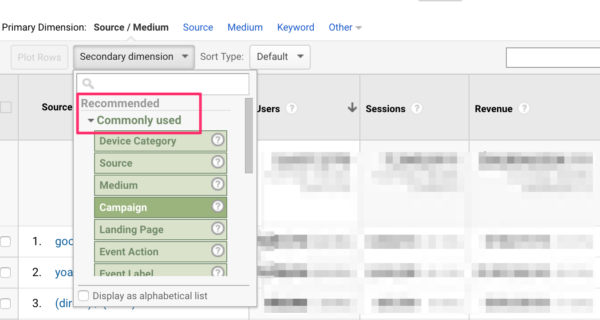Grasping SEO: Using Secondary Dimensions for Boosted Analytics
Wiki Article
Enhance Your Data Evaluation Using Second Dimensions
The true depth of insights lies in the combination of secondary dimensions. The tactical usage of second measurements elevates analysis beyond the surface level, guaranteeing a wide range of untapped possible waiting to be discovered.Understanding Additional Dimensions
Additional measurements in information evaluation describe added attributes or metrics that provide deeper insights when combined with primary data dimensions, enhancing the overall understanding of the dataset. These additional dimensions provide a more extensive view of the data, permitting experts to discover covert patterns, connections, and patterns that may not be obvious when only considering main dimensions.By including secondary dimensions into data analysis, experts can obtain an extra nuanced understanding of the aspects affecting the main metrics. For instance, in advertising and marketing analysis, main dimensions might include basic consumer demographics like age and sex, while additional dimensions can include variables such as buying habits, choices, or geographic location. By integrating these second and main measurements, analysts can create more detailed client accounts, allowing more targeted and efficient marketing approaches.
Moreover, secondary measurements can help in recognizing connections in between different variables, bring about more exact predictive modeling and decision-making. They allow analysts to check out information from several viewpoints, enriching the understandings attracted from the dataset and inevitably enhancing the top quality of analysis and calculated recommendations.
Advantages of Second Dimensions
When taking into consideration information analysis, incorporating additional measurements uses a plethora of benefits that considerably improve the depth and breadth of insights obtained from primary information measurements. By including second measurements such as time, place, or market info to the evaluation, researchers can acquire a much more detailed understanding of the key information points.Furthermore, second dimensions can additionally help in segmenting information, enabling a more detailed evaluation of certain subsets within the main data. This segmentation can bring about more targeted approaches and activities based on the unique attributes of each section. Additionally, second measurements can aid in verifying findings from key information dimensions, providing an extra durable and trustworthy basis for decision-making.
Fundamentally, the advantages of integrating additional dimensions right into information analysis are invaluable, supplying richer insights and enabling even more informed decision-making procedures.
Carrying Out Secondary Measurements Efficiently
Effective execution of additional measurements in data evaluation needs a strategic technique that maximizes the energy of added contextual info. When incorporating additional measurements, it is important to straighten them with the main measurements to acquire much deeper insights into the information. Start by clearly specifying the objectives of the check over here evaluation to determine which additional measurements will provide one of the most pertinent context. It is vital to select additional measurements that complement the main information without creating noise or confusion in the evaluation.Additionally, consider the scalability of the additional measurements throughout various datasets or analyses. Ensure that the selected additional measurements can be continually used and interpreted across various scenarios to maintain the stability and consistency of the analysis. Additionally, develop an organized procedure for incorporating second measurements right into the analysis workflow to streamline the interpretation of results. By carrying out additional dimensions efficiently, analysts can enhance the deepness and precision of their data analysis, bring about even more educated decision-making and actionable insights.
Advanced Techniques With Secondary Measurements
For a much more sophisticated approach to information evaluation, integrating secondary dimensions can dramatically raise the deepness of insights gotten. Advanced strategies with second dimensions entail even more complex techniques to extract valuable details from information collections. One such strategy is cohort evaluation, where information is segmented based upon certain qualities or actions to track patterns in time. This approach enables for a much deeper understanding of exactly how various groups advance and communicate with your services or product.An additional sophisticated strategy is regression evaluation, which helps recognize relationships between variables and just how they impact each other. By adding second dimensions, such as market info or customer actions, to regression models, you can discover extra nuanced understandings and make more exact predictions.

Situation Studies: Additional Dimensions at work

In another circumstance, a doctor leveraged additional dimensions to enhance resource appropriation. By examining client end results in connection with geographical location, the company determined Get More Info locations with high readmission rates. This led to the application of targeted intervention programs in those areas, eventually improving individual care and minimizing healthcare prices.
These case researches illustrate the power of additional dimensions in discovering beneficial insights that drive critical decision-making. By delving deeper into data evaluation beyond main metrics, companies Bonuses can gain an extra comprehensive understanding of their clients and procedures, leading to more enlightened and effective business methods.
Verdict
In conclusion, the consolidation of second dimensions in data analysis is crucial for gaining a detailed understanding of underlying trends and aspects. By making use of techniques such as accomplice evaluation and regression evaluation, companies can reveal hidden insights and make more informed decisions. Additional measurements include deepness and breadth to information evaluation, permitting businesses to explore data from multiple point of views and drive a lot more reliable end results.In advertising and marketing analysis, primary measurements might include standard client demographics like age and gender, while second dimensions can include variables such as buying actions, preferences, or geographical location.When thinking about information analysis, incorporating second measurements uses a plethora of benefits that significantly enhance the deepness and breadth of understandings derived from primary information dimensions.In addition, additional measurements can also aid in segmenting data, enabling for a more in-depth evaluation of particular parts within the primary information. Additionally, additional measurements can aid in verifying searchings for from main information dimensions, offering an extra dependable and durable basis for decision-making.
When including secondary dimensions, it is critical to align them with the main measurements to obtain deeper insights right into the information.
Report this wiki page